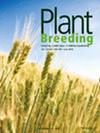甘蔗(Saccharum spp.)家系的基因组大小和染色体数目变异以及表型对比鲜明的甘蔗基因型
IF 1.5
4区 农林科学
Q2 AGRONOMY
引用次数: 0
摘要
现代甘蔗(Saccharum spp.)栽培品种起源于复杂的杂交过程,从而产生了复杂的多倍体和非整倍体基因组。流式细胞术(FCM)是研究植物基因组大小的一种精确而快速的方法,它有可能揭示甘蔗细胞遗传学的关键方面。本研究采用 FCM 探针估算了 175 种甘蔗基因型的 2C DNA 含量,这些基因型包括表型对比强烈的甘蔗(商业栽培品种、甘蔗杂交种和甘蔗自交系)和全同种甘蔗家族。FCM 介导的 DNA 含量估计在预测染色体数目方面表现出很高的准确性,为传统细胞遗传学程序提供了一种省时高效的替代方法。DNA 含量与表型性状之间的低幅度相关性表明,利用 FCM 介导的 DNA 含量估算对农艺性状进行间接选择可能并不有效。甘蔗家系中的 DNA 含量变异模式因杂交而异,并揭示了与猖獗的非整倍体有关的转基因变异。总之,这些发现揭示了遗传物质的损失或增益是高遗传变异的一个来源,可能会对作物育种产生重大影响。本文章由计算机程序翻译,如有差异,请以英文原文为准。
Genome size and chromosome number variation in sugarcane (Saccharum spp.) families and phenotypically contrasting Saccharum genotypes
Modern sugarcane (Saccharum spp.) cultivars originated from an intricate hybridization process, resulting in complex polyploid and aneuploid genomes. Flow cytometry (FCM), which has emerged as a precise and fast method for research on genome size in plants, has potential to unveil key aspects of sugarcane cytogenetics. In this study, FCM probes were conducted to estimate 2C DNA content in 175 Saccharum genotypes embracing phenotypically contrasting canes (commercial cultivars, energy‐cane hybrids, and a Saccharum spontaneum
求助全文
通过发布文献求助,成功后即可免费获取论文全文。
去求助
来源期刊

Plant Breeding
农林科学-农艺学
CiteScore
4.40
自引率
5.00%
发文量
74
审稿时长
3.0 months
期刊介绍:
PLANT BREEDING publishes full-length original manuscripts and review articles on all aspects of plant improvement, breeding methodologies, and genetics to include qualitative and quantitative inheritance and genomics of major crop species. PLANT BREEDING provides readers with cutting-edge information on use of molecular techniques and genomics as they relate to improving gain from selection. Since its subject matter embraces all aspects of crop improvement, its content is sought after by both industry and academia. Fields of interest: Genetics of cultivated plants as well as research in practical plant breeding.
 求助内容:
求助内容: 应助结果提醒方式:
应助结果提醒方式:


